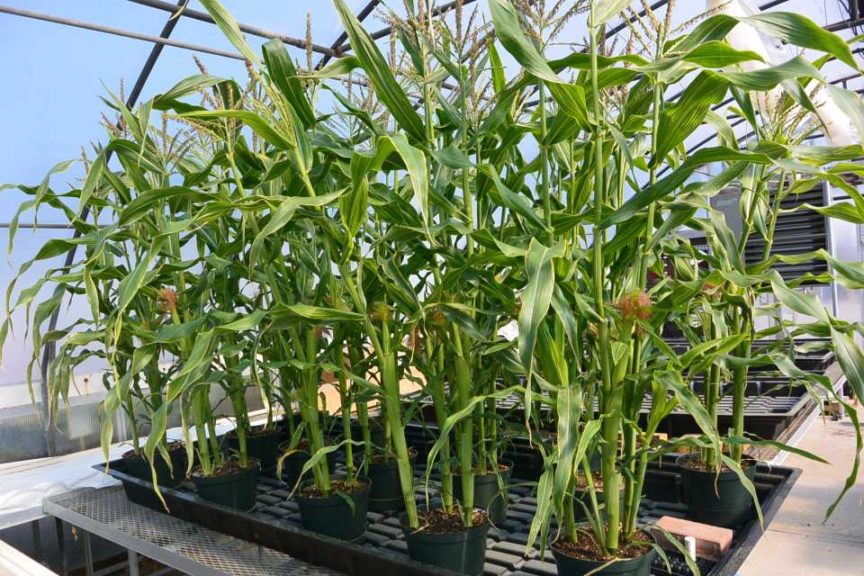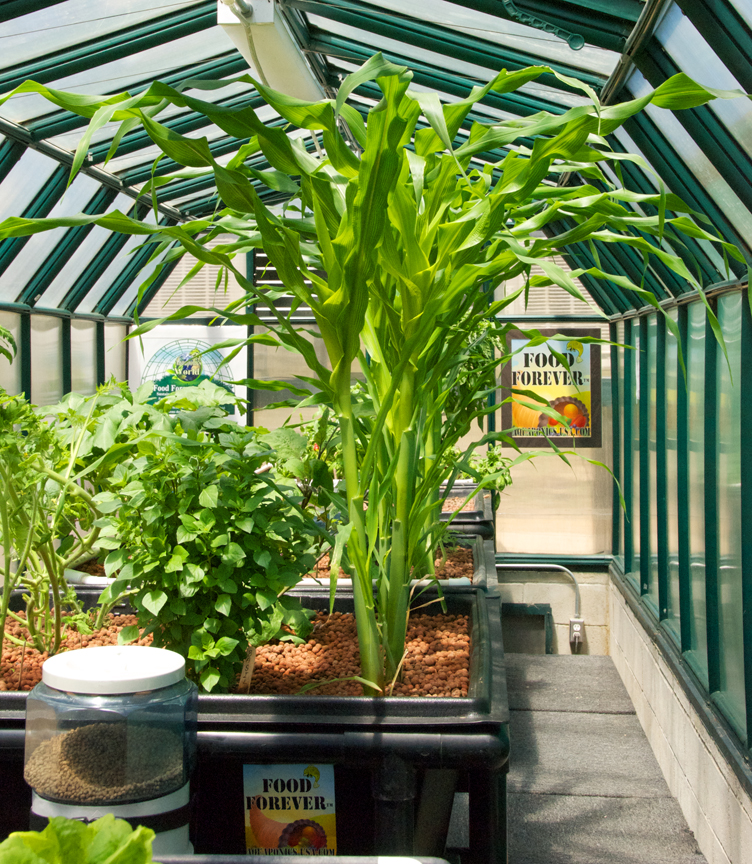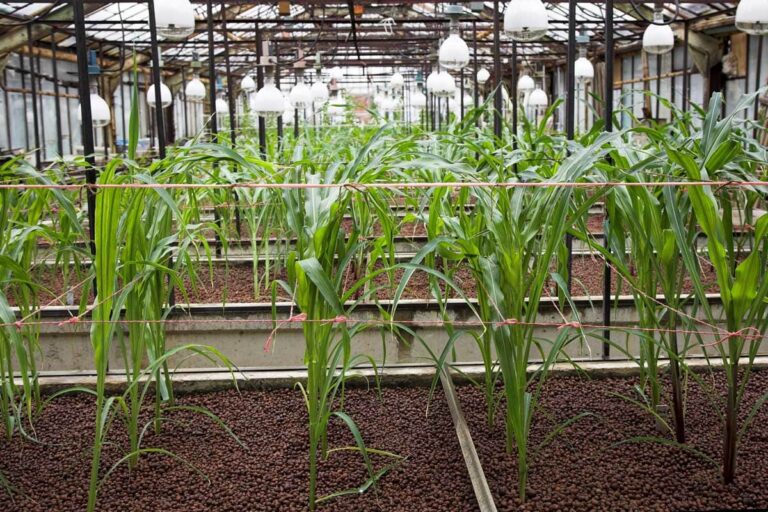As I stood inside my greenhouse, the warm, earthy scent of fertile soil filling the air, I couldn’t help but wonder: Can you really grow corn in a greenhouse?
It’s a question that has intrigued me for some time, and I was on a mission to find out. The concept of cultivating this staple crop in a controlled environment seemed both ambitious and rewarding.
So, armed with curiosity and a desire to experiment, I embarked on a journey to discover the secrets of year-round maize cultivation under glass.
However, Growing corn is simple. It’s a warm-season crop that takes 60-100 days to grow. Plant seeds 2 inches deep, 4-6 inches apart, with rows 30-36 inches apart. Keep it warm between 60-80°F, and it’ll sprout in 7-10 days.It can grow tall, up to 8 1/2 feet, so give it space. Plant beans, marigolds, nasturtiums, alyssum, yarrow, or spinach nearby to help it grow well. That’s it – easy and delicious corn in your garden.
Whether you’re a seasoned gardener looking to diversify your crops or a curious enthusiast like me, join me to explore the fascinating world of greenhouse corn cultivation.
What are the important factors in growing corn in a greenhouse?

Growing corn in a greenhouse successfully requires careful attention to several important factors to ensure optimal growth and yield:
Variety Selection: Choose corn varieties that are well-suited for greenhouse cultivation. Consider dwarf or bushy varieties that require less vertical space and have a compact growth habit.
Soil and Potting Mix: Use a high-quality, well-draining potting mix or greenhouse soil that is rich in organic matter. It requires fertile soil with good moisture retention.
Planting and Spacing: Start corn seeds indoors in seed trays or pots, and transplant them into the greenhouse when they are about 3-4 inches tall with a couple of sets of leaves. Space the plants according to the recommendations for your chosen variety, usually 12-18 inches apart in rows.
Support Structures: Plants can grow tall and may require support to prevent them from falling over. Use stakes, trellises, or other support structures to help keep the plants upright.
Temperature and Humidity: Maintain a greenhouse temperature between 75-85°F (24-29°C) during the day and slightly cooler at night. Keep humidity levels in the range of 50-70%, as corn prefers moderate humidity.
Watering: Keep the soil consistently moist but not waterlogged. Also, it requires regular watering, especially during hot weather. Drip irrigation or a soaker hose can help avoid wetting the foliage.
Fertilization: Provide essential nutrients through a balanced, slow-release fertilizer or organic compost. Follow the recommended dosage guidelines on the fertilizer package.
Lighting: It needs direct sunlight. You must ensure that the plants are receiving enough sunshine if you want to cultivate maize within a greenhouse as opposed to outside. Choose the side of your greenhouse that receives the most sunlight, or use grow lights if necessary.
Pest and Disease Management: Monitor for pests such as aphids, spider mites, and caterpillars. Use natural or organic pest control methods when possible, and keep the greenhouse well-ventilated to reduce the risk of fungal diseases.
Pollination: It is wind-pollinated, and the greenhouse environment may lack the necessary breeze for pollination. You can facilitate pollination by gently shaking the corn plants when the tassels (male flowers) release pollen, ensuring it reaches the silk (female flowers) of the ears.
Harvesting: Harvest corn when the kernels are plump and milky for sweet corn. For baby corn, harvest when the ears are small and tender.
Successive Planting: To extend your corn harvest, consider planting new batches of corn every 2-3 weeks.
What are the benefits of growing corn in a greenhouse?
Greenhouse cultivation indeed offers distinct advantages when it comes to safeguarding your corn crop. Firstly, you won’t contend with birds pilfering your precious seeds and ears, as the enclosed space acts as a protective shield.
Furthermore, pest control becomes more manageable in a greenhouse environment, with fewer concerns about uninvited guests like raccoons and troublesome flea beetles. The ample sunlight within the greenhouse accelerates growth, leading to potentially faster maturation.
Additionally, the extended growing season allows for multiple corn harvests each year, ensuring a steady supply. Notably, greenhouse-grown corn lets you avoid GMO varieties on your dinner plate, as you have control over seed selection. Moreover, pesticide use is entirely in your hands, meaning you can maintain a pesticide-free crop unless necessary.
How to plant sweet corn in a greenhouse?
Warm-Season Crop: Corn is a warm-season crop, so ensure that your greenhouse maintains a consistently war
Germination: Maize germinates best at temperatures between 60-95°F (15-35°C). Expect the seeds to emerge within 7-10 days after planting.
Companion Planting: Enhance the growth of your corn crop by companion planting. Consider planting beans, marigolds, nasturtiums, alyssum, yarrow, and spinach alongside your maize. These companion plants can provide benefits such as improved pollination and natural pest control.
Avoid Certain Companions: Keep in mind that there are plants to avoid planting near your corn in the greenhouse. Steer clear of pumpkins, cantaloupes, watermelons, tomatoes, and sunflowers, as they may compete for resources or create unfavorable conditions for corn.
Support Structures: Given that corn can reach a height of 8 1/2 feet, you should implement sturdy support structures such as stakes or trellises to prevent the tall plants from falling over as they grow.
Lighting: Corn requires ample direct sunlight. Ensure that your greenhouse is positioned in a location that receives abundant natural light, and if needed, use supplementary grow lights to maintain adequate light levels for healthy growth.
Temperature Control: Maintain a greenhouse temperature within the preferred range for maize, with daytime temperatures between 60-80°F (15-27°C) and slightly cooler nights.
Watering: Keep the soil consistently moist but not waterlogged. Maize requires regular watering, especially during warm weather. Consider using drip irrigation or soaker hoses to prevent wetting the foliage.m environment, with temperatures ideally ranging between 60-80°F (15-27°C).
Seed Selection: Choose maize varieties that are suitable for greenhouse cultivation, such as compact or dwarf types that can accommodate the limited space. These varieties are often ideal for reaching the 8 1/2 ft height within the confines of a greenhouse.
Planting Depth and Spacing: Plant the maize seeds approximately 2 inches deep in the soil or potting mix within your greenhouse. Space the seeds 4 to 6 inches apart within rows, and ensure that rows are separated by a distance of 30-36 inches. This spacing allows enough room for the corn plants to grow and spread.
Common problems harvesting corn in the greenhouse?

Limited Space Challenge: The tall growth of these plants can pose challenges in a confined greenhouse. To address this, it’s essential to strategize and plan for accessing and harvesting the upper portions of the plants without causing damage to either the crop or yourself.
Pollination Challenges: These plants typically rely on wind pollination, which might be lacking in the controlled environment of a greenhouse. To address this issue, consider the manual intervention of gently shaking the flowering plants. This helps facilitate the essential pollination process.
Overcrowding Issue: Dense planting within the limited space of a greenhouse can lead to fierce competition for light and nutrients among the plants. The result may be smaller yields and an overall decrease in production. Therefore, ensuring proper spacing during the planting phase is crucial to avoid this problem.
Fungal Disease Risk: The high humidity within greenhouses can create a conducive environment for the development of fungal diseases, such as mold or mildew, on the plants. Effective mitigation strategies involve implementing adequate ventilation and employing careful watering practices.
Pest Infestations: While greenhouses offer some protection against outdoor pests, certain insects like aphids and spider mites can still infiltrate your crop. To prevent pest-related issues, it’s essential to conduct regular plant inspections and employ suitable pest control measures when necessary.
Timing Consideration: Harvesting at the correct stage is vital for ensuring the best flavor and texture. Delayed harvesting can result in suboptimal product quality, affecting its overall appeal. Optimal timing is key to a successful harvest.
Storage Precautions: Properly storing the harvested produce is crucial to preserving its freshness and flavor. Having a designated storage area within or outside the greenhouse that maintains appropriate temperature and humidity levels is essential to ensure the longevity of the crop.
Successive Planting Strategy: If you plan to have multiple harvests within the same greenhouse, meticulous scheduling and timing of planting are essential. This prevents the overwhelming scenario of having all the produce ready for harvest simultaneously.
Physical Demands: Harvesting can be physically demanding, particularly from tall greenhouse-grown plants. To address this challenge, it’s advisable to equip yourself with the appropriate tools and, if possible, seek assistance to ensure a safe and efficient harvest.
Quality Assurance: Maintaining quality control during the harvest process is paramount. This entails vigilant inspection of the harvested produce to identify and remove any damaged or pest-infested items. Such measures prevent issues from spreading and ensure the highest-quality yield.
FAQs
How long does corn take to grow?
Corn typically takes 60 to 100 days from seed to harvest, depending on the variety and growing conditions.
What country grows the best corn?
The United States is one of the largest producers of high-quality corn globally, known for its extensive corn cultivation and advanced agricultural practices.
What country is rich in corn?
Mexico has a rich history of corn cultivation and is considered the birthplace of maize. It has a diverse range of corn varieties and culinary traditions centered around this crop.
Are corn plants hard to grow?
No, Corn plants can be moderately challenging to grow successfully. They require specific conditions and care to thrive.
Is corn plant easy to grow?
Yes, Corn plants can be grown with relative ease in the right conditions, but attention to detail is essential for a healthy crop
Final word
In simple words, I’ve discovered that growing corn in a greenhouse is not only doable but also quite an exciting journey. Inside my greenhouse, I have complete control over things like temperature, light, and watering – all the things that corn really loves.
Also, I’ve learned a few tricks along the way, like choosing the right types of corn and giving them enough space to grow comfortably. It’s like giving them their own little corn kingdom inside the greenhouse.
To help the corn reach its impressive height, I’ve set up some sturdy support structures inside the greenhouse. And to make sure they get enough sunlight, I’ve positioned the greenhouse in just the right spot.
Further, taking care of my corn is a bit like taking care of a garden inside a cozy bubble. It’s not just about the corn I get to enjoy at the end; it’s about the whole adventure of growing it in my little greenhouse. So, yes, you can grow corn in a greenhouse, and it’s a fascinating journey from start to finish!

